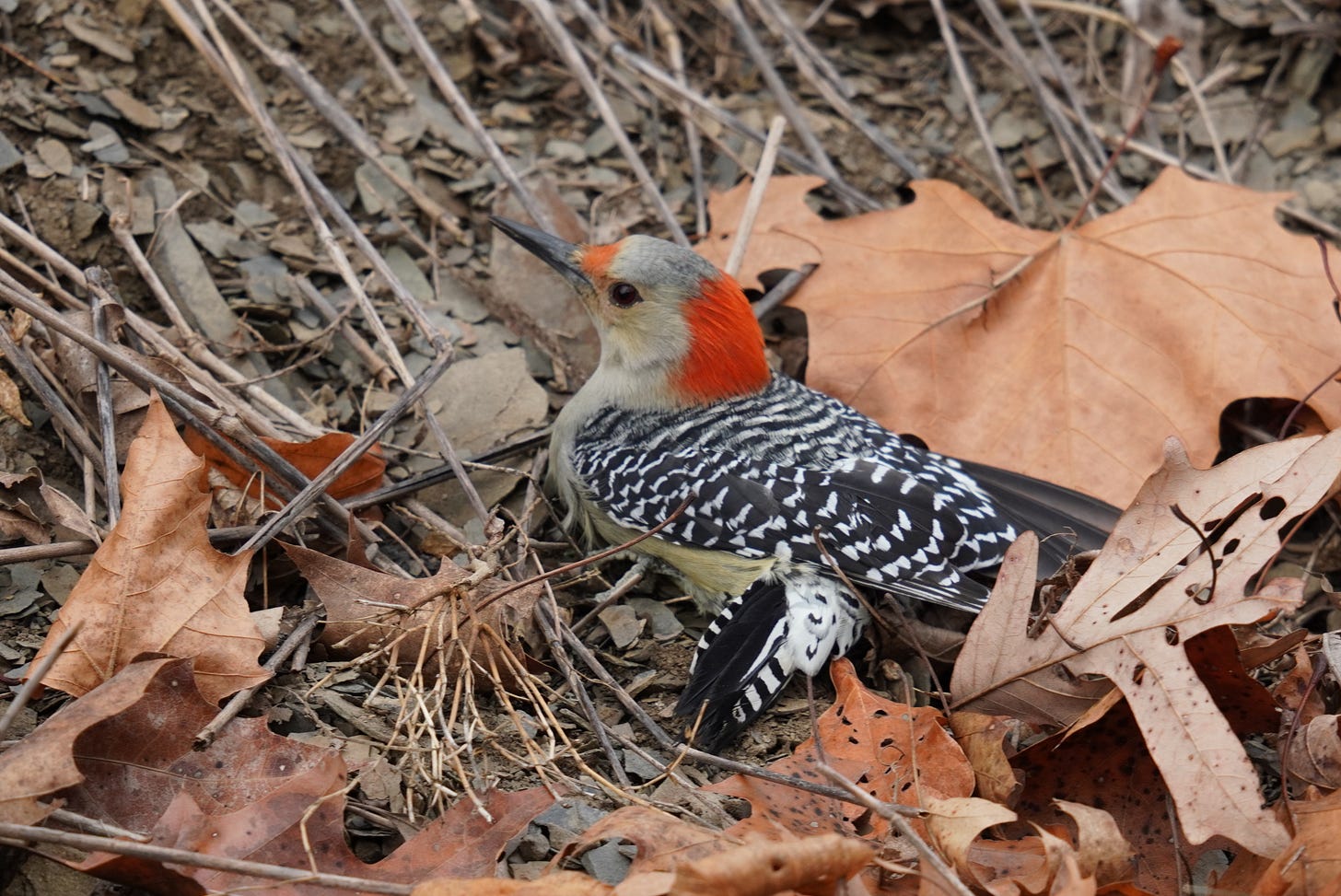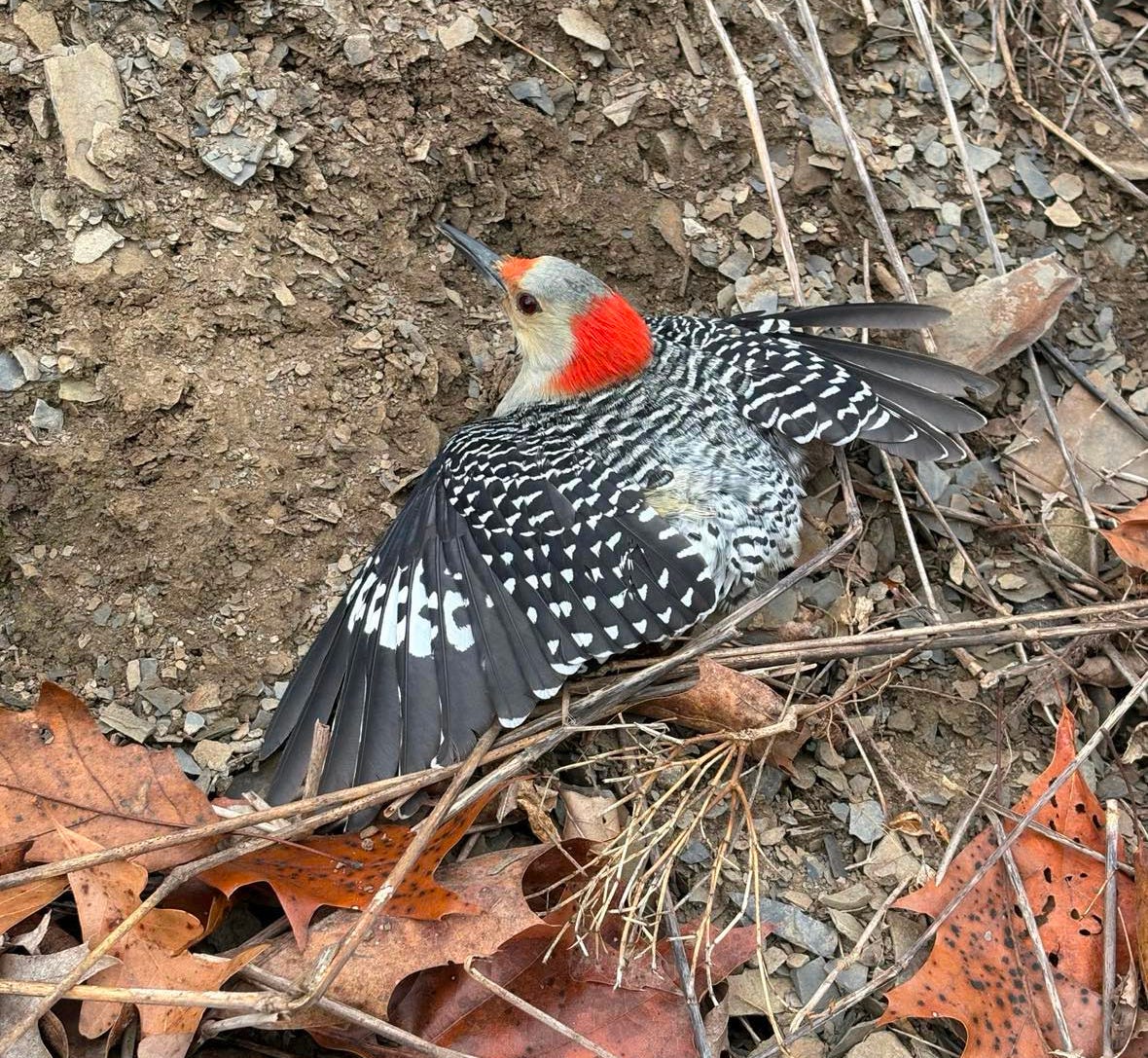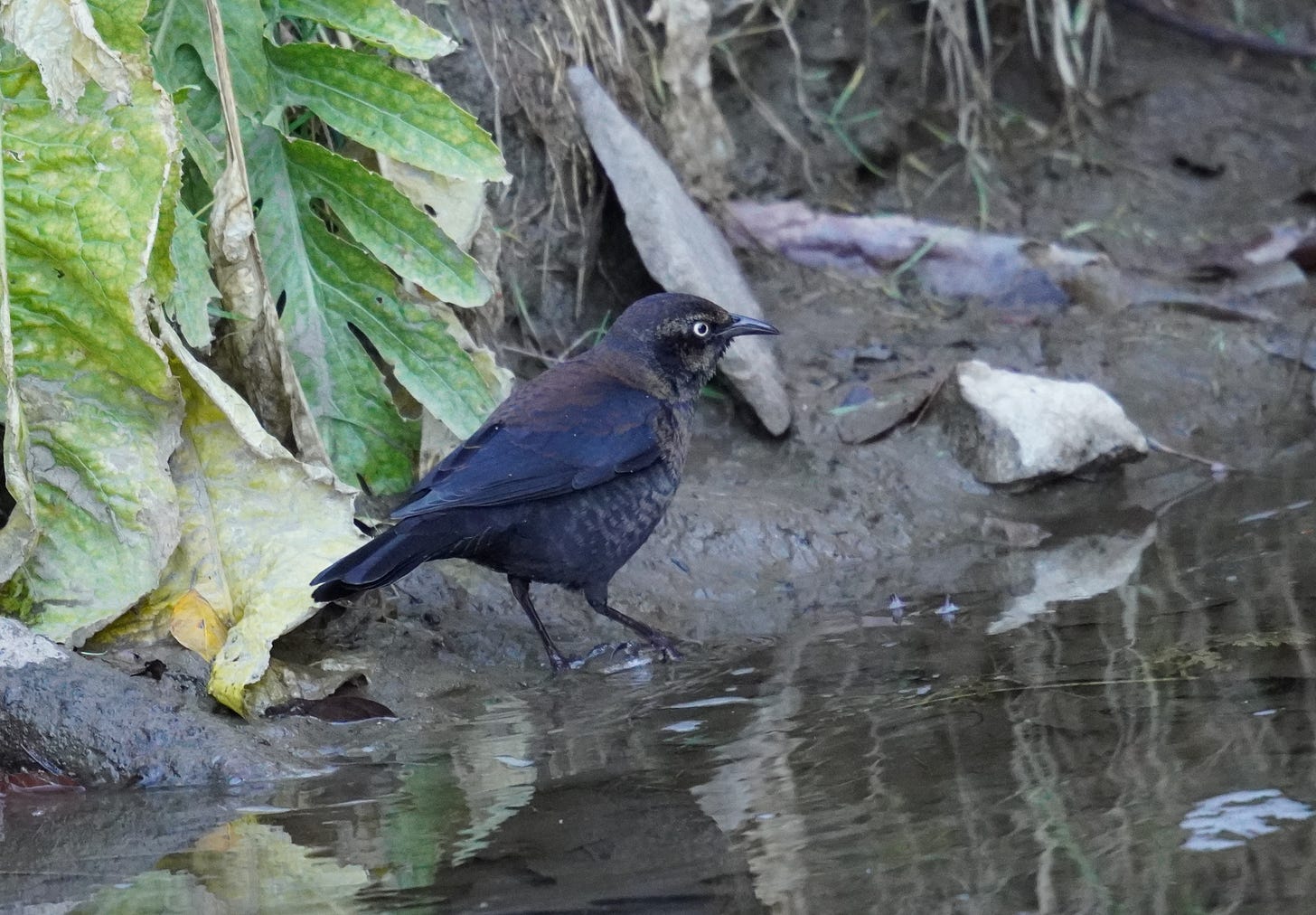I emailed Humane Animal Rescue yesterday to see how the injured Red-bellied Woodpecker I found on the railroad tracks last week was getting along. From the start, I wasn’t optimistic about her chances. Her tail feathers were perpendicular to her body, and she appeared capable of moving only in tiny, ineffective hops. What the cause was, I can’t say, but something in that little body was badly broken.
To my untrained eye, the outlook seemed…not great. On the other hand, I’m no animal doctor, and I’m not one for armchair diagnoses. All I knew for sure was getting the bird into competent hands was crucial if she was ever going to peck wood again.
Animal rescue’s voicemail greeting provided detailed instructions on how to catch and transport a wild animal to their facility (no venomous reptiles, please). I hurried home for a box and ten minutes later found her exactly where I’d left her. This was gonna be a snap.
Or so I thought. The closer I inched, the louder she barked. “Calllm down,” I said in my least threatening voice, but woodpeckers are shit at understanding English, and my idiotic reassurances did little to soothe her. When I got too close for her comfort, she managed to launch herself into something resembling flight. Airborne but wobbly, she crossed over the tracks and would have found refuge in the nearest tree, but her injury turned the landing into a collision, and soon enough she was on the ground again.
My good intentions were causing more harm, and I was close to giving up as she squirmed down the bank of the creek and into a thicket, where she came to rest. The ordeal seemed to have sapped her remaining energy, and so I determined to try one more time. I made my way through the briars now separating us, picking up many scratches and, I later found out, one tick along the way. She lay there panting, wary but resigned. I was able to place the box over her and slide the lid under. For the moment, she was safe.
We had a 30-minute drive ahead of us, during which, the voicemail instructed, I was not to play the radio in any capacity. Already injured and distressed, music or talk in an enclosed environment could cause further harm, even death. I drove as quietly and gently as I could along the Pittsburgh roads, and the bird remained docile during the ride.
Only when I parked did she become restless, scratching and screeching as I carried the box into the facility. Poor thing must have been terrified in the dark, and I couldn’t help wonder—should I have bothered? Was I making things worse for the already beleaguered bird? Nature has a way of dealing with wounded creatures. Maybe it would have been better to leave her be.
I don’t know. It’s hard to watch an animal suffer. I told myself if they couldn’t mend whatever was wrong, at least they could give her a quicker and less painful death than the one looming on the side of the railroad tracks. I felt better when my friend Holly, who volunteers at the facility, texted that the people who work there are great at rehabbing birds. Once the intake process was complete, my hopes that patient #4305 could have a happy ending were buoyed.
One might ask, why such a fuss over one bird, a common woodpecker whose population numbers appear to be stable? At any time of the year, there are three or four Red-bellied Woodpeckers around the yard. I can spot ten or more during one of my walks without breaking a sweat. Hell, as I type this I swear I hear the telltale tap-tap-tap of a Red-bellied moronically trying to drill into the vinyl siding.
So why fuss? Because it’s rough out there for birds, much rougher than it has to be. Aside from natural predators and diseases, birds are facing many threats introduced by humans. Windows and house cats alone are responsible for billions of bird deaths each year. Combine that with habitat destruction and climate change and it all adds up to one conclusion—birds are in trouble.
Take Rusty Blackbirds, for instance. Here’s one I found on Tuesday.
It’s a stunning bird I find especially gorgeous this time of year in its non-breeding plumage. I was grateful for the visit, not just because I added a new yard bird, but also because by some estimates their numbers have declined more than 80% in the last half century. The reasons aren’t entirely clear to scientists, but one thing is clear to me—the fast, steep drop of Rusty Blackbirds, Evening Grosbeaks, Bank Swallows, and many others should be enough to set the hair on fire of anyone remotely conservation-minded.
Even birds like the Dark-eyed Junco, which can flock in big numbers and seem to easily pass the eye test for abundance, have declined alarmingly over recent decades. That brings us to our Red-bellied Woodpecker. Common birds are common only until they aren’t, and they can become uncommon breathtakingly fast.
Just ask the Passenger Pigeon, which numbered 3-5 billion in the early 1800s and was gone forever 100 years later.
So yes, I do think we should save a single bird when we can. If we only worry about a species when it becomes threatened, by then it may be too late.
And on a personal level, birds bring such joy to my days and have become so integral to my mental health, that if this human can help a single injured woodpecker, I feel that’s a small way to repay a huge debt.
That’s why I fussed a week ago, and not for the first time.
In April 2023, I found a Mallard drake whose legs were entangled in some wire that was attached to a piece of wood, making basic Mallard functions (swimming and flying), nearly impossible. Worse still, the poor duck was on the nerves of some nesting Canada Geese, who didn’t take kindly to the racket.
I didn’t know how to help this bird. I called the state game commission, which sent a volunteer out later that day. By the time she arrived, there were no Mallards to be found, which in my optimistic mind meant the duck had somehow freed himself and flown off. Perhaps he succumbed, but I prefer to think he’s one of the regulars I see during my walks.
Skittish Wood Ducks also seem to enjoy those ponds and the cover the cattails and other plants provide. I can’t imagine the distress this little Wood Duck chick was feeling when it somehow got separated from its flock and stuck between the rails of the train tracks.
Those steel barriers made the chick the proverbial fish in a barrel—trapped, exposed, and vulnerable to just about anything that would gobble a baby bird. Though it tried to run, its pitiful strides were no match for a six-foot human, even a slow-footed one. Wings flapped uselessly as I reached down for the flightless bird, but in the water the awkward duckling became suddenly graceful. More Wood Ducks were across the pond. Family? I don’t know, but it swam toward them. All I could do was hope it would be welcomed (back) into the flock.
Birds need our help, sometimes in small ways, and sometimes not so small. Solving habitat loss and climate change are massive challenges with powerful people involved and tons of money at stake. The cat problem? Piece of cake, because keeping domesticated cats indoors is easy. Or is it? Turns out cat owners can be stubborn about letting their pets roam free (if you want to see sparks fly, pop some corn and bring the subject up on any neighborhood Facebook group), but outdoor cats have a devastating impact on ecosystems and are often themselves victimized by predators, traffic, etc. Keeping them inside is better for everyone.
Another easy way to help birds stay alive is to turn off urban building lights during migration. Most birds migrate by night, and urban lights can cause disorientation and window strikes. A lone building (Chicago’s McCormick Place is perhaps the most notorious) can kill hundreds of birds in the course of a single migration, and thus turning lights off during those critical weeks can save many lives. Again, easy, but with one similar obstacle—building owners can be stubborn too.
What’s to be done? Some minds won’t be changed, but perhaps with education and outreach, enough people will come around to begin to reverse the trend. Maybe the billions of birds lost will become millions, and then hundreds of thousands… Maybe we can help threatened species avoid the fate of the Passenger Pigeon.
As for the fate of my Red-bellied Woodpecker? At the time of publication I had yet to hear back. I promise to end the suspense the moment I get some news, good or bad. Here’s hoping she’s back outdoors soon, that she gets through the winter to nest and breed and raise many more woodpeckers next spring. We’re gonna need them.
Featured Photo - White-throated Sparrow
Not long ago I was lamenting my inability to get a picture of a White-throated Sparrow (population down 33% from 1966-2019). Let me be clear—my frustration was aimed fully at myself. These birds are secretive, yes, but with a little more patience than I’d been willing to exert (and possibly a bit of pishing), they can be captured. I didn’t need to pish with this one, who seemed content to perch and survey the landscape, a perfect pose for my coveted photo.
I’ve always had a thing for White-throated Sparrows. I remember first seeing one under our feeder in Indiana, so striking with crisp white head stripes, the signature throat, and those glorious golden lores above the eyes. I was captivated, and it immediately vaulted to the top of my list of favorite sparrows. And this bird isn’t just another pretty face. To me, their song is among the most haunting and beautiful sounds in nature. Perhaps most fascinating is that they come in one of two color morphs, those with white-striped heads, and those with tan stripes. Though one can’t tell the sex of a White-throated Sparrow by eye, one color morph is most likely to mate with the other. I’m not 100% sure which morph I captured above. It could be a trick of the light, but the subtle color toward the back of the stripe has me leaning tan. Does it matter? Is one morph better than the other? The answer is NO.
10/10 Recommends
I met Holly during a birdwalk last year, and she quickly became one of my favorite people to bird with. Tons of skills, none of the ego, all the passion. I’ve never seen anyone get as excited about an Ovenbird as Holly did this fall. I feared the sudden paroxysm was the onset of a stroke, but I was wrong. It was undiluted joy. That kind of enthusiasm is contagious, and it also fuels her Substack, where she writes about birds with wit and insight. For my money, there are few better ways to learn than when you’re laughing at the same time 🦆 😂 🐦 🤣
The holidays are nearly upon us, and I can’t think of any better gift to give a bird lover than bird-related art. Nicole Ellis is talented New Hampshire-based painter who has a wonderful birdhouse series and did an extraordinary job with this crow I commissioned for my wife Alex.
And if birds aren’t the thing this year, Nicole is also handy at painting lobsters (and barns and trucks and landscapes too!) 🎨 🐦⬛ 🖌️ 🦞
That’s all for this week. Have you ever felt compelled to intervene during an encounter with injured wildlife? If so, how did it go? Tell us about it in the comments.
Until next time, bird your ass off!
nwb












I used to volunteer at my local animal shelter and transporting birds to rehab quickly became my job. My favorite was a Peregrine Falcon I had nicknamed Millennium and the most challenging was a Mute Swan with a violent case of diarrhea. I hope your woodpecker survives.
If one of the ‘Pigs with wings’ was injured in the garden, I would be right there to aid it in any way I could. I think some point early in life, you either are a rescuer or are not. If I turned away without aiding, I would be ‘woulda, coulda, shoulda’ for the rest of my life.